Exploring the Charm of Chibi Vampires in Anime and Manga
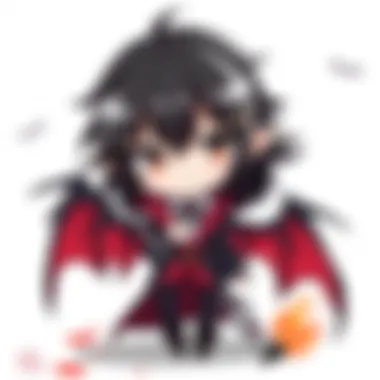
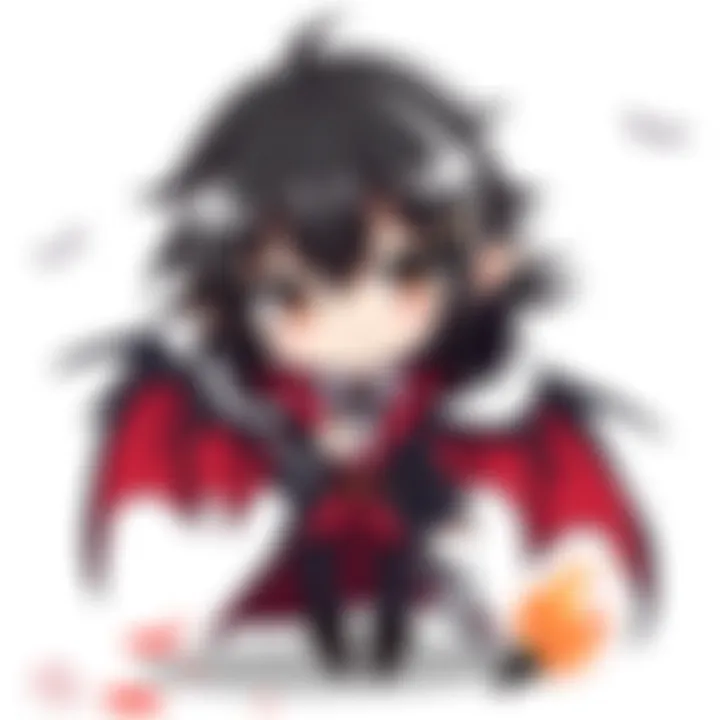
Intro
In the colorful universe of anime and manga, where conventions often take creative turns, the chibi vampire emerges as a captivating character archetype. These pint-sized bloodsuckers, characterized by their exaggerated features and endearing expressions, twist traditional vampire lore into something both humorous and heartwarming. Their allure isn’t just about looking cute; it dives deep into the cultural significance they bear, the themes they embody, and the artistic choices that bring them to life on screen and page.
Chibi vampires typically manage to mix whimsy and intrigue. They serve as a parallel to the more conventional depictions of vampires, which are often steeped in darkness, mystery, and horror. The transformation into chibi form softens these traits, inviting viewers and readers to engage with characters that might otherwise be viewed as threatening. It’s a curious blend; they retain the supernatural essence while embodying a cuteness that compels audiences to cheer them on instead of running away.
Understanding the charm of chibi vampires requires us to look closely at the series they inhabit. This exploration reveals the fabric of storytelling that blends humor, cultural signifiers, and the aesthetics of animation that make these characters stand out. Let’s dive into the essence of their world as we uncover the stories behind them.
Prologue to Chibi Vampires
Chibi vampires hold a unique place within anime and manga communities, not merely as entertainment but as symbols amalgamating cuteness with darker narratives. This section lays the groundwork by diving into the broad appeal and significance of chibi vampires, illustrating how their diminutive forms serve as both delighting representations while managing to retain ties to traditional vampire lore. Understanding this will help elucidate the interactions of innocence and darkness that these characters embody, echoing themes that resonate strongly with audiences.
The bold aesthetic of chibi vampires makes them captivating, often acting as a gateway into conventions where horror meets adorability. Unlike their traditional counterparts, these pint-sized fiends engage audiences on multiple levels. Readers and viewers are drawn into their worlds, as chibis create an interesting juxtaposition of fun and fear. The conversations around chibi vampires are ongoing, continuing to challenge our perceptions of these age-old symbols of horror. When examining these animated figures, one can appreciate how anime and manga creators innovate and reinterpret vampire mythology, transforming them into lighthearted characters without completely stripping away their historical undertones.
Defining Chibi Aesthetics
Chibi, originating from the Japanese word meaning "small," embodies a distinct art style known for its exaggerated features and oversized heads. This style encapsulates a sense of playfulness, which stands in stark contrast to the typically serious imagery associated with vampires. The chibi aesthetic often involves simplified facial features, larger-than-life eyes, and a range of bright colors. These characteristics help convey emotions vividly and allow for greater relatability, focusing on characteristics often overlooked in traditional portrayals.
In the realm of chibi vampires, this aesthetic variation manifests in several ways:
- Exaggerated Emotions: The designs often reflect a wide array of emotions. A chibi vampire who’s surprised might have its mouth agape, unlocking instant laughter among viewers.
- Visual Clarity: The simplicity of design allows for straightforward storytelling, making it easier for audiences to follow plot developments without getting bogged down in complex character designs.
- Dynamic Colors: Bright palettes usually accompany these supernatural beings, often showcasing pastel hues, or striking contrasts that enhance the charm rather than evoke terror.
Thus, as each detail unfolds, one realizes that chibi aesthetics do much more than merely amuse. They breathe new life into the vampire genre, inviting audiences to experience fear in an unexpectedly playful manner.
The Vampire Archetype in Japanese Media
Throughout Japanese media, the vampire archetype has seen considerable evolution, communicating changes in societal attitudes and deeper thematic explorations. Early representations depicted vampires primarily as terrifying figures, lurking in shadows, but modern portrayals have adapted significantly. Chibi vampires exemplify this shift. They are often caricatures of the classic vampire archetype, presenting an idea of what it means to be a vampire, wrapping it in themes of youth and innocence.
In a genre where darkness typically reigns, chibi vampires emerge as counterpoints, becoming conduits for humor, tenderness, and sometimes just sheer silliness. They can engage in relationships filled with camaraderie while navigating absurd situations typical of slice-of-life genres. Their appeal inevitably lies in how creators integrate these playful aspects alongside familiar tropes:
- Romance and Friendships: Chibi vampires frequently find themselves in relational arcs riddled with cuteness. These characters maintain the classic themes surrounding potential love interests while ensuring that no actual threat looms overhead.
- Conflict Reimagined: Instead of the traditional good versus evil plots, chibi vampires often wrestle with issues like fitting into school life or learning how to blend in with humans, creating narratives relevant to everyday experiences.
- Comedic Relief: Their antics serve as a refreshing break from darker themes, making stories more balanced and approachable, thus appealing to various audience segments.
Altogether, chibi vampires embody a progression in storytelling within Japanese media, simultaneously embracing their heritage while appealing to modern sensibilities.
Historical Context of Vampires in Culture
Understanding the historical context of vampires is vital to appreciating chibi vampires in anime and manga. Vampires have been a part of human storytelling for centuries, deeply rooted in folklore, mythology, and later popular culture. These creatures have evolved dramatically across cultures, holding different meanings and symbolism. This historical grounding contributes to the richness of chibi representations by offering layers of irony, nostalgia, and contrast against their more sinister counterparts.
Global Vampire Mythologies
Vampire legends are as diverse as the cultures they emerge from. In Europe, tales of the vampire—a creature haunting the night and preying on the living—often stemmed from superstition and a lack of understanding of decaying corpses. The Slavic vampire, for example, is cloaked in mystery, varying from the seductive and charming to the grotesque and terrifying. In Romania, the myth of Dracula has become iconic, influencing countless adaptations and interpretations.
"Vampires reflect our deepest fears and desires, intertwining life, death, and the shadows of our psyche."
Across Asia, myths differ significantly. The Chinese jiangshi is a reanimated corpse that seeks to absorb the life essence of the living. In Japan, kappa and yurei can sometimes take on vampiric characteristics, showing the fluidity between various supernatural beings. These diverse interpretations show how geography, language, and local traditions shape the undead narrative.
In the Americas, stories often adapt to local contexts, providing their own unique spins on the vampire lore. The Chupacabra, while not a vampire in the traditional sense, shares an essence of bloodlust and terror, revealing how different cultures interpret vampirism in their societal ambiance. This informtion feeds into the broader tapestry of vampire lore, setting the stage for their chibi representations in anime and manga.
The Evolution of the Vampire Persona
The conception of vampires has transformed drastically over time, evolving from terrifying fiends to more nuanced characters in literature and visual media. Early representations often framed vampires as nightmarish entities, embodying the anxieties surrounding disease, death, and the unknown. However, with the advent of modern literature, notably works like Bram Stoker's "Dracula," vampires became symbols of seduction, power, and forbidden desire.
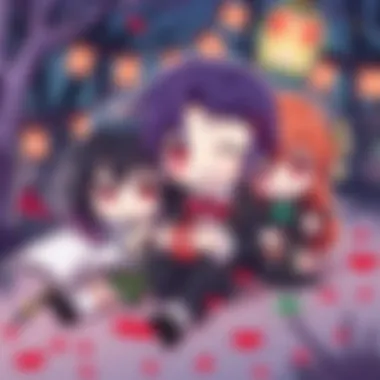

In Japanese culture, the evolution takes a unique twist. The yokai—supernatural spirits— blended with the notion of the vampire to create figures that were not only fearsome but also complex, reflecting deeper themes of loneliness and longing.
Chibi vampires flip this persona on its head. These diminutive and adorably exaggerated figures spark a resurgence of the earlier horror tropes but through a cute lens. Their chibi forms playfully distort the sinister aspects of traditional vampires while still nodding to their roots. What's more, they engage a modern audience, drawing upon a vast history of vampire mythos to create endearing representations that maintain a playful edge yet retain emotional depth.
By tracking the transformation of vampires throughout various cultures and time periods, one gains a clearer view of why chibi vampires resonate today. They serve as charming, accessible conduits between the earlier, darker images and the multifaceted nature of vampiric lore in contemporary media.
Chibi Vampires in Popular Series
Chibi vampires have carved out a distinct niche within the anime and manga scenes, becoming beloved figures for their unique blend of charm and mischief. This section emphasizes their significance in popular series, showcasing how these pint-sized portrayals add depth to storytelling while simultaneously capturing viewer's hearts. The whimsical nature of chibi vampires allows creators to explore vampire lore with a playful twist, enabling a fresh perspective on age-old myths.
Notable Examples Across Genre
Chibi vampires can be seen across different genres, adding a sprinkle of sweetness to narratives that might otherwise tread darker themes. Here are some noteworthy examples:
- Shiki – Although predominantly dark, this series includes chibi-style depictions of certain characters, softening their otherwise sinister undertones.
- Vampire Knight – Incorporates chibi elements in comedic scenes, allowing characters to showcase more light-hearted interactions amidst serious plots.
- Rosario + Vampire – Focused on a school setting with supernatural beings, this show features chibi vampires, merging humor with a varied ensemble cast.
- Kawaii Anarchy – An underground comic that dives into the daily lives of chibi vampires navigating contemporary society, offering a unique take on the classic vampire tale.
These examples highlight the versatility of chibi vampires as they blend seamlessly into various storytelling styles.
Character Analysis of Iconic Chibi Vampires
Chibi vampires often come with distinct traits that enrich their respective narratives. These traits can be dissected into three main areas: design elements, personality traits, and plot roles.
Design Elements
Design Elements form the visual identity of chibi vampires. The exaggerated proportions and playful aesthetics allow for a connection to be formed with the audience. One key characteristic is the oversized heads and large expressive eyes, which convey a sense of innocence. This design can often be appealing in a viewer's eye, allowing them to relate to the character easily.
- Unique feature: The smaller bodies and adorable facial expressions of chibi vampires stand in stark contrast to traditional vampires, which often embody a brooding nature. This juxtaposition provides a humorous perspective on what could be serious themes.
- Advantages: This design choice plays into the idea of "cutification," thus making them more marketable for merchandise, from plush toys to prints.
Personality Traits
The Personality Traits of chibi vampires usually encompass endearing qualities, making them lovable characters. They tend to exhibit a playful side, often caught in antics that showcase innocence rather than malice. A significant trait is their vulnerability—while traditional vampires might conjure fear, chibi vampires evoke empathy and affection.
- Key characteristic: Their child-like curiosity often leads to humorous situations, which can be a refreshing change from the usually dark and serious tones of vampire narratives.
- Unique Feature: This personality aspect helps soften the archetype, turning potential threats into figures that blend seamlessly into light-hearted stories or comedic relief.
Plot Roles
In terms of Plot Roles, chibi vampires serve a variety of functions within their narratives. Often, they are depicted as side characters who provide comic relief while driving secondary storylines.
- Key characteristic: Many chibi vampires function as a foil to serious protagonists, highlighting themes of friendship and loyalty through their lively antics.
- Unique Feature: Their roles often allow for greater audience engagement since they can influence key plot points without overshadowing main character arcs, providing balance in storytelling.
In summary, the combination of unique design, playful personality, and significant plot functions create an irresistible allure for chibi vampires, further embedding them in the fabric of anime and manga storytelling.
Thematic Significance of Chibi Vampires
Chibi vampires occupy a unique space in the already rich tapestry of anime and manga storytelling. Their small, often exaggerated forms carry a weight of thematic significance that allows creators to explore multifaceted ideas surrounding both innocence and the darker aspects of human nature. Through these diminutive characters, stories convey complex emotions, ranging from humor to poignant reflections on love, fear, and mortality. As a result, chibi vampires serve not only to entertain but also to provoke thought and stir the imagination, making them valuable icons in modern Japanese media.
Exploring Themes of Innocence and Darkness
At first glance, chibi vampires invoke a sense of cuteness and playfulness, a stark contrast to the traditional, fearsome image most are familiar with. This juxtaposition is clever, as it highlights the layered nature of their existence. The cartoonish features of these vampires enable a portrayal of innocence that doesn’t shy away from their vampiric roots.
For example, in series like Kawaii Hito no Yado where the chibi vampire Akira navigates a world full of humans, his naivety often leads to humorous situations. He inadvertently frightens unsuspecting schoolmates with his fanged smile, a simple yet potent visualization of innocence colliding with fear. Here, the audience witnesses the stark contrast between the character's juvenile intent and the supernatural implications of his abilities.
Moreover, this theme can also be seen through the lens of storytelling, where chibi vampires navigate complicated relationships and moral dilemmas. The narrative pushes and pulls between the playful traits of their design and the somber realities often intrinsically linked to vampire lore, encompassing themes such as survival, ethics surrounding predation, and existential dread. Thus, authors employ chibi vampires to delve into deeper narratives that otherwise might seem inaccessible if tackled through a more conventional lens.
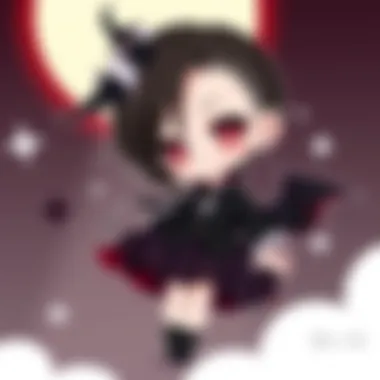
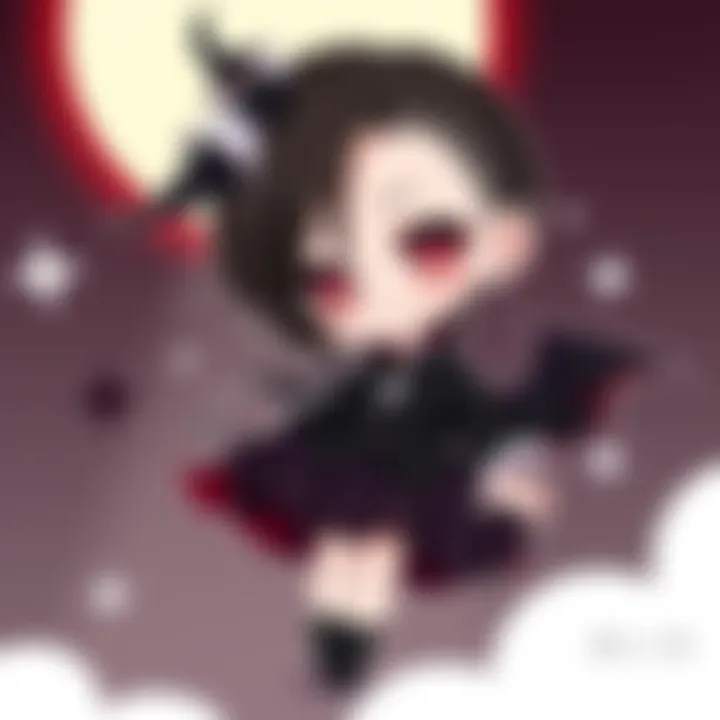
The Role of Humor in Chibi Vampire Depictions
The presence of humor is a defining trait in stories featuring chibi vampires. Their exaggerated features and silly antics resonate well not only with the comedic elements but also enhance the relatability of their experiences. This lightheartedness allows audiences to engage with often serious themes in a more palatable manner.
Humor comes into play when these characters wrestle with their vampire identity. For instance, a chibi vampire, upon realizing that garlic bread is not just a necessary evil but a delicacy in human cuisine, may embark on a comedic quest to rediscover his place in a world that often regards vampires with suspicion. The blend of comedy and traditional tropes softens the darker themes, making them digestible for varied audiences.
Additionally, their blundering attempts to fit into human society often yield situations that are filled with both absurdity and comedy. This approach provides a canvas for social commentary, where the awkwardness of chibi vampires can mirror the struggles of regular people – whether it be fitting in or facing fears. By using humor as a narrative tool, authors create a connection to the audience, showing that despite differences, everyone grapples with feeling out of place.
In summary, the thematic significance of chibi vampires extends far beyond their superficial charm. They embody a rich confluence of innocence and darkness while offering a unique lens through which humor and social critique can flourish. As we continue to explore their world, we uncover deeper reflections of our human experience.
These characters are a playful exploration of the duality of existence, mixing whimsy with profound undertones in a refreshing way.
For further insight on the cultural intricacies of vampire representations, you can check resources at Britannica, or for community discussions visit Reddit.
Character Design and Artistic Choices
Character design serves as the lifeblood of chibi vampires, enriching the portrayal of these endearing figures and merging traditional lore with contemporary flair. It's not merely about how they look; it's also a conduit for expressing their personalities and thematic significance. For fans and creators alike, the choice of design elements can evoke emotions, influence storytelling, and create a deeper connection with the audience.
Visual Characteristics of Chibi Style
Proportions and Features
The proportions in chibi style are strikingly different from typical character representations. Chibi vampires often flaunt exaggerated features: large heads, oversized expressive eyes, and tiny bodies. This gives them a unique charm, steering away from the menacing characteristics traditionally associated with vampires. Such proportions make the characters appear more approachable and playful, embodying an innocence that contrasts sharply with their supernatural origins.
A notable characteristic of these proportions is the heightened expressiveness they offer. In the realm of anime and manga, where emotional resonance plays a crucial role, this design choice is a boon. By magnifying facial features, creators can easily convey a wide range of emotions—from sheer joy to outrage—with just a blink or a smile. This heightened expressiveness can endear chibi vampires to viewers, making them memorable and likable. However, the downside often comes in the form of reduced drama. The cuteness sometimes overshadows the darker tones of traditional vampire lore.
Color Palettes
Color is another significant factor in chibi design, often characterized by vibrant and pastel hues. This approach to color infusion injects a lively energy into the figures. Unlike traditional vampire portrayals enveloped in dark and muted tones, chibi vampires tend to sport playful color palettes that encapsulate their whimsical flavor while hinting at the charming yet dark undercurrent of their vampire nature.
Vivid colors invigorate these chibi characters, creating a visual feast that enhances the overall aesthetic appeal. Bright pinks, soft blues, and gentle purples are common, providing a stark contrast to the foreboding skies often depicted in vampire narratives. The advantage of such palettes lies in their ability to draw in a younger audience, capturing attention and fostering engagement. However, the challenge arises in balancing the cuteness with the inherent darker aspects of vampire mythology, as some consumers might find this disjunction jarring.
Contrast with Traditional Vampire Designs
The juxtaposition between chibi vampires and conventional vampire designs couldn't be starker. Traditional representations of vampires are often drenched in an atmosphere of horror, sophistication, and danger. These figures typically sport intricate capes, menacing fangs, and a generally somber demeanor that prioritizes fear over fun.
In contrast, chibi vampires turn this established trope on its head. With their childlike proportions and innocent expressions, they present a fresh angle that invites laughter rather than terror. Their design choices embrace playfulness, inviting not only a different type of fandom but also a diverse set of storytelling opportunities that can explore themes of friendship, adventure, and even comedy.
Through several series—like Kawaii Vampire and Chibi Vampires vs. Zombies—the disparity becomes patently clear. Chibi vampires might doodle on the edges of their capes, while traditional vampires brood in the shadows. Consequently, this shift not only reflects changing attitudes towards the vampire mythos but also indicates a broader openness in media to explore lighter takes on classic stories.
Cultural Impact of Chibi Vampires
Chibi vampires have carved out a unique niche in the expansive world of anime and manga, making their presence felt far beyond just the pages of comic books or frames of animation. Their cultural impact is seen in various forms, influencing merchandise, fan art, and the overall reception of the vampire archetype in contemporary media. This section aims to delve into the significance of these diminutive creatures, exploring how they resonate with audiences and contribute to the larger landscape of pop culture.
Influence on Merchandise and Fan Art
The cuteness factor of chibi vampires has sparked a wave of merchandise that caters to fans of all ages. From plush toys and figurines to keychains and clothing, the appeal of these small, adorable creatures can be found on shelves worldwide. Companies such as Good Smile Company and Banpresto have dedicated lines focusing on chibi versions of popular vampire characters, often featuring creative designs that encapsulate their essence in a playful manner.
Moreover, fan art plays a crucial role in the chibi vampire phenomenon. Artists on platforms like DeviantArt and Pixiv showcase their interpretations, reflecting diverse styles and ideas. Many artists are inspired by the playful juxtaposition of a traditionally dark character like a vampire represented in a cute, chibi style. This often leads to variations that explore themes of love, humor, and even horror in endearing ways.
- Stuffed Animals: Custom chibi vampire plushes can be found, offering fans a tangible piece of their beloved characters.
- Apparel: T-shirts featuring chibi designs attract both young fans and adult collectors.
- Prints and Posters: Artists create limited-edition prints that resonate with the chibi style, further fueling interest.
"Chibi vampires encapsulate a blend of innocence and mischief, making them ideal subjects for fan interpretations that bridge genres."
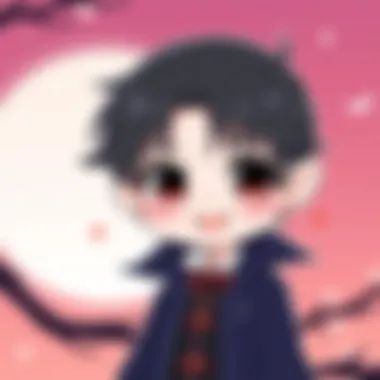

Fandom and Community Reception
Within the community, chibi vampires have fostered a unique subculture that celebrates both the humorous and serious aspects of vampire lore. Online forums and social media platforms like Reddit and Facebook have become vibrant spaces for discussion, where fans share their love for chibi vampires and engage with one another. The charm of these characters offers an entry point for new fans, drawing them into the larger vampire narrative in anime and manga.
Fan conventions often showcase panels dedicated to the discussion of chibi aesthetics, where enthusiasts share techniques for creating art or even cosplay inspired by chibi vampires. This interaction strengthens community ties and forms a collective identity founded on a shared love for these diminutive versions of classic creatures.
In addition to individual appreciation, numerous fan projects and social media hashtags are dedicated to chibi vampires, amplifying their presence and impact within the fandom. Hashtags like #ChibiVampireArt can easily trend, leading to collaborative projects that connect fans across the globe, fostering a sense of belonging and shared multicultural appreciation.
Psychological Appeal of Chibi Vampires
In the colorful and often surreal world of anime and manga, chibi vampires stand out not just for their adorable designs but also for their emotional resonance with audiences. The psychological appeal of these pint-sized bloodsuckers is multifaceted, intertwining cuteness with deeper themes that invite introspection and connection. Examining this allure reveals much about the human psyche and our need for both comfort and complexity in storytelling.
The Attraction of Cutification
Chibi style, characterized by exaggerated features and a whimsical aesthetic, evokes a sense of nostalgia and innocence. This cutification process is not merely about making characters look cute; it taps into our innate desire to protect and connect with something that seems harmless and endearing. The small stature, big eyes, and rounded faces of chibi vampires resemble infants or pets, triggering nurturing instincts in viewers.
When we see a chibi vampire, we are drawn in by their oversized heads and tiny bodies, which create a stark contrast to traditional portrayals of vampires as foreboding and sinister.
This approach results in several psychological benefits:
- Relief from Stress: The charm of chibi vampires can provide a sense of escapism, allowing fans to step away from the harsher realities of life.
- Emotional Connection: Characters designed in this style often signify purity and vulnerability, eliciting empathy from audiences.
- Complexity Beneath the Surface: While they may appear cute, chibi vampires often embody darker themes, inviting viewers to explore the juxtaposition of light and dark.
Underlying Subtexts in Chibi Representation
Beneath the surface of their adorable appearances, chibi vampires serve as a canvas for exploring significant cultural and psychological themes. This duality is particularly impactful as it challenges perceptions surrounding the vampire mythos.
First, consider the concept of innocence tainted by darkness. Chibi vampires often retain some traditional vampire traits—like thirst for blood or an affinity for night—but their portrayal contrasts with expectations:
- Innocent Mischief: They may engage in playful antics rather than the usual horror tropes, lightening the narrative while still subtly nodding to the spectral origins.
- Conflict of Nature: Their existence as cute yet somewhat malevolent beings prompts questions about good and evil, personal struggle, and the nature of desire.
- Cultural Reflection: In some cases, these characters reflect societal fears or fascinations with the supernatural, enabling deeper philosophical dialogues.
Additionally, chibi vampires embody a form of rebellion against traditional gender roles and societal expectations. Their design allows for exploration of identity and the breaking of molds, offering narratives where they can be defenders, mischief-makers, or even reluctant heroes.
"Chibi vampires remind us that even within the seemingly innocent, there may lurk deeper shadows — a perfect metaphor for the complexities of human nature."
As we analyze the psychological depths of chibi vampires, it becomes clear that their charm is more than just visual appeal; it’s a concoction of nostalgia, innocence, and complexity that resonates with both the heart and mind, making them an essential part of the vast tapestry of anime and manga culture.
Future Trends of Chibi Vampires in Media
The allure of chibi vampires continues to evolve, adapting to the shifting landscapes of anime and manga. As creators push the boundaries of storytelling and art, the significance of chibi vampires will likely grow. Understanding these future trends is essential for enthusiasts and scholars alike, highlighting how cultural changes influence character representations and themes.
Emerging Themes and Styles
Looking ahead, a few emerging themes and styles are set to reshape the portrayal of chibi vampires in media.
- Tension between Light and Dark: This theme marries the playful nature of chibi aesthetics with the underlying darkness typically associated with vampires. Series might experiment with mixing horror and comedy, using chibi characters to explore darker themes in a light-hearted manner. For instance, a chibi vampire might face dilemmas revolving family ties or identity, while maintaining a comedic tone.
- Diverse Representation: The notion of diversity in character designs may also come into play. As audiences become more globally interconnected, you might see chibi vampires reflecting a variety of cultural backgrounds. This can lead to intriguing storylines that blend folklore from different regions with the traditional vampire mythos.
- Interactive Media: With the rise of mobile gaming and interactive storytelling formats, chibi vampires could become central figures in new types of gameplay. Imagine a mobile app where you care for your chibi vampire, making choices that impact their story in real time—an exciting way to immerse fans in the world of these diminutive bloodsuckers.
Such innovations could keep the allure fresh and continuously engaging, drawing in new fans and keeping existing one's entertained.
Potential Cross-Cultural Adaptations
As the popularity of anime and manga grows internationally, the potential for cross-cultural adaptations of chibi vampires is huge.
- Adaptations to Western Markets: The concept of chibi vampires could find its footing in Western comics or animation styles, perhaps incorporating aspects of superheroes or graphic novels. This fusion could deliver stories that appeal to a broader audience and introduce chibi vampires to those unfamiliar with anime.
- Cultural Collaborations: Collaborations between creators from different countries could yield exciting new takes on chibi vampires. By integrating Western vampire lore with distinctly Japanese aesthetics, we may witness unique narratives that explore untapped story potential. This might also involve partnerships in live-action adaptations, allowing for a deeper exploration of cultural nuances.
"Chibi vampires might soon become ambassadors of a blended culture, bridging gaps and fostering connections between vastly different audience."](https://en.wikipedia.org/wiki/Vampire)
- Transformation into Various Formats: As seen with other successful series, chibi vampires may also branch off into different formats such as novels, video games, and even live-action media. This kind of expansion can encourage creative freedom, allowing new generations of creators to bring their vision of what chibi vampires can be.
In summary, the future of chibi vampires in media is rife with potential. Emerging themes like the playful tension between light and dark, along with efforts to embrace diverse representations, will certainly enrich the discourse surrounding these beloved characters. Adaptations across cultures and media formats may further propel the chibi vampire into fresh realms, ensuring that their charm remains captivating for years to come.



